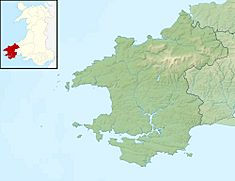Melin Tregwynt facts for kids
Melin Tregwynt (which means Tregwynt Mill) is a special woollen mill in Wales. It's found in a tiny village called Tregwynt in Pembrokeshire. For a very long time, this mill has taken wool from local sheep farms. It turns the wool into yarn, then weaves it into beautiful cloth and blankets. Today, Melin Tregwynt is famous for its stylish blankets, cushions, clothing, and other cool items.
Contents
The Mill's Story: A Look Back in Time
Melin Tregwynt woollen mill is hidden in a quiet valley. It's very close to the beautiful Pembrokeshire Coast Path. The mill building itself is old, with a date of July 1819 on its roof. It was first used as a corn mill, grinding grain. Later, in the 1800s, it changed into a woollen mill.
Local farmers would bring their sheep's wool to the mill. The mill workers would wash, clean, and spin the wool into yarn. Then, they would weave the yarn into warm blankets.
Powering the Mill: Water Wheel Magic
The mill used water from a nearby stream to power its machines. What's cool is that the water wheel is inside the building! This large iron wheel was probably built in the late 1800s.
At first, the water wheel powered hammers. These hammers would beat the woven cloth to make it clean and soft. Later, the wheel used leather belts to power other machines. These included engines for carding (combing wool) and looms for weaving. You can still see this old machinery in the mill today.
A Family Business: Growing Over the Years
The current owner's grandfather bought the mill in May 1912 for £760. He ran the business with his son. During World War II, the mill mostly made knitting wool. This type of wool was not rationed, meaning people could still buy it easily.
In the 1950s, the family opened a shop at the mill for visitors. They also opened shops in nearby towns like St Davids and Fishguard. This helped Melin Tregwynt become a well-known brand. The business did very well in the 1960s and 1970s. It even survived tough economic times in the 1980s when many other Welsh mills closed. The founder's grandson later joined the business. He helped the mill start selling its products to other countries.
Melin Tregwynt Today: Global Style
In 1997, the mill was weaving about 2 miles (3.2 km) of cloth every month! Today, Melin Tregwynt sometimes sends out some parts of the process, like carding and spinning. The mill's old water wheel still works, but it doesn't power the machines anymore.
In 2008, the Guinness Book of Records noted something fun. Melin Tregwynt had woven the world's largest picnic blanket for a supermarket called Waitrose. In 2012, the mill celebrated 100 years as a family business. Now, they weave for people all over the world.
The mill still makes stylish blankets, cushions, bags, and other finished items. The looms are still set up by hand, knots are tied by hand, and blankets are finished by hand. Melin Tregwynt also has a cafe at the mill. There's also a shop that sells clothes, bags, lampshades, and ceramics.
Featured Designs and Appearances
In September 2012, Melin Tregwynt was shown at Heal's in London. This was part of the London Design Festival. Also in 2012, Welsh fashion designer Jayne Pierson created special women's clothing for Melin Tregwynt. The mill was even featured on a BBC Two Wales TV show called Made in Wales in December 2012.
You might have seen their products on TV shows too! They've been on shows like Big Brother and Doctor Who. In 2013, the mill showed its designs at the Milan Furniture Fair. In 2015, a Melin Tregwynt design was used for a dance. This dance was performed by the National Theatre Wales and Theatr Genedlaethol Cymru.
As of 2016, about 30 people work at the mill. The mill building is a Grade II listed building. This means it's an important historical building that is protected.
Images for kids







